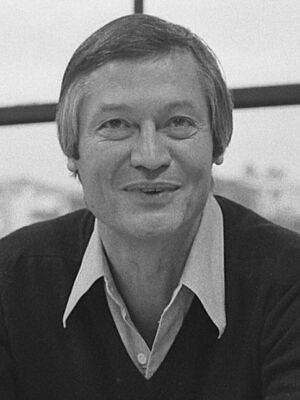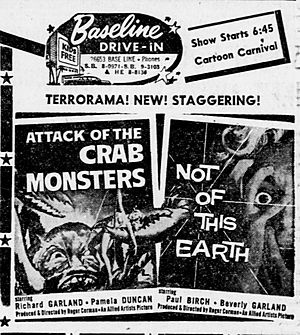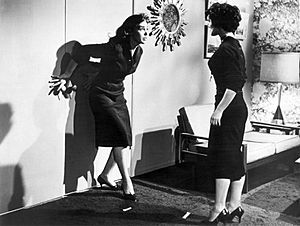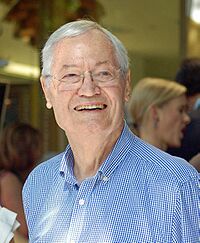Roger Corman facts for kids
Quick facts for kids
Roger Corman
|
|
|---|---|

Corman in 1978
|
|
| Born |
Roger William Corman
April 5, 1926 Detroit, Michigan, U.S.
|
| Died | May 9, 2024 (aged 98) Santa Monica, California, U.S.
|
| Alma mater | Stanford University (BS, Industrial Engineering, 1947) |
| Occupation |
|
| Years active | 1954–2024 |
| Spouse(s) |
Julie Corman
(m. 1970) |
| Children | 4 |
| Relatives | Gene Corman (brother) |
| Military career | |
| Allegiance | United States |
| Service/ |
United States Navy |
| Years of service | 1944–1946 |
| Battles/wars | World War II |
Roger William Corman (born April 5, 1926 – died May 9, 2024) was an American film director, producer, and actor. He was known as "The Pope of Pop Cinema" and "The King of Cult." Corman was a pioneer in making independent films, often with small budgets. Many of his movies were cult favorites, including some based on stories by Edgar Allan Poe.
In 1964, Corman became the youngest filmmaker to have his films shown in special collections at famous places like the Cinémathèque Française in Paris and the Museum of Modern Art in New York. He helped start New World Pictures and New Concorde. In 2009, he received a special Academy Honorary Award for helping so many films and filmmakers get started.
Corman was also famous for bringing many movies by well-known foreign directors to the U.S. These directors included Federico Fellini from Italy and Akira Kurosawa from Japan. He guided and helped many young film directors like Francis Ford Coppola, Ron Howard, and Martin Scorsese. He also helped start the careers of actors such as Jack Nicholson and William Shatner.
Corman sometimes acted in movies made by directors he had helped. These roles included parts in The Godfather Part II (1974) and Apollo 13 (1995). A documentary about his life, Corman's World: Exploits of a Hollywood Rebel, came out in 2011.
Contents
- Early Life and Education
- Starting a Film Career (1950s)
- The Filmgroup (1959)
- Famous Adaptations and Studio Work (1960s)
- Working for Major Studios
- Return to Independent Films (1965–1971)
- New World Pictures
- New Horizons
- Concorde Pictures
- Roger Corman Presents
- Other Projects
- Filmography
- Roger Corman's Cult Classics
- Favorite Films
- Personal Life and Death
- Awards and Legacy
- Documentary
- See also
Early Life and Education
Roger Corman was born in Detroit, Michigan. His father, William Corman, was an engineer. Roger's younger brother, Gene, also became a film producer. Roger and Gene grew up in a Catholic family.
Corman went to Beverly Hills High School. Then he studied industrial engineering at Stanford University. While at Stanford, he realized he didn't want to be an engineer. He joined the V-12 Navy College Training Program and served in the United States Navy from 1944 to 1946. After the war, he returned to Stanford and earned his degree in 1947.
In 1948, Corman worked for only four days as an engineer. He quickly realized it was a mistake. His brother Gene was already working in the film business. So, Roger decided to try filmmaking instead.
Starting a Film Career (1950s)
Corman first found a job in the mail room at 20th Century Fox. He worked his way up to reading stories for films. He liked one story very much and gave ideas for it. This story became the film The Gunfighter. But Corman received no credit for his work. Because of this, he left Fox and decided to make films on his own.
Corman later studied English literature at the University of Oxford in England. He also lived in Paris for a while. When he returned to Los Angeles, he took different jobs to get back into the film industry. He worked as a television stagehand and a messenger. He also helped a literary agent.
Corman wrote a movie script in his free time. He sold it for $2,000. This script became the film Highway Dragnet (1954). Corman also worked on the film as an associate producer without pay. He did this just to gain experience.
Corman used the money from his script and his contacts to raise $12,000. This money helped him produce his first movie, a science-fiction film called Monster from the Ocean Floor (1954). It was successful enough to encourage him to make more films.
His next film was a racing thriller, The Fast and the Furious (1955). Years later, the title of this film was used for the very popular Fast & Furious movie series. Corman sold his film to a new company called the American Releasing Company (ARC). He chose ARC because they promised to give him money to make two more movies.
Corman decided to direct his second film for ARC. It was a Western called Five Guns West (1955). He made it in color for about $60,000. Corman then directed other films, including Apache Woman (1955) and Day the World Ended (1955), a popular science-fiction film.
Beverly Garland, an actress who often worked with Corman, said he made them work very hard. She remembered his amazing energy and knew he would be a huge success.
ARC later changed its name to American International Pictures (AIP). Corman became their main filmmaker. They funded his next film as a director, the science-fiction story It Conquered the World (1956). This movie was a big hit.
Corman made several other films for AIP and other companies. These included The Undead (1957) and Not of this Earth (1957). He also made Attack of the Crab Monsters (1957), which was one of his most successful early films.
Corman received his first serious praise for Machine-Gun Kelly (1958). This film was about a famous gangster and gave Charles Bronson his first main role. Corman also helped produce The Cry Baby Killer (1958), which was Jack Nicholson's first starring role.
The Filmgroup (1959)
In 1959, Corman started his own company called The Filmgroup with his brother Gene. This company made or released low-budget black-and-white films. These movies were often shown as two films together at drive-in theaters.
For AIP, Corman made a dark comedy called A Bucket of Blood (1959). He then used a similar script and many of the same actors for The Little Shop of Horrors (1960). This film was supposedly shot in just two days and one night.
Corman directed The Wasp Woman (1959) for Filmgroup. He also made two films back-to-back in South Dakota: Ski Troop Attack (1960), a war movie, and Beast from Haunted Cave (1959). He then went to Puerto Rico and produced two more films at the same time: Battle of Blood Island (1960) and Last Woman on Earth (1960). He even made a third film, Creature from the Haunted Sea (1961), while there.
Famous Adaptations and Studio Work (1960s)
AIP wanted Corman to make two horror films with small budgets. But Corman wanted to make bigger, color films. He suggested adapting "The Fall of the House of Usher" by Edgar Allan Poe. AIP agreed.
The film, House of Usher (1960), starred Vincent Price. It was a big success with both critics and audiences. Because of this, AIP wanted more Poe adaptations. Corman, Price, and the same team made The Pit and the Pendulum (1961). This was another big hit, and the "Poe cycle" of films began.
Corman directed The Intruder (1962), which was one of William Shatner's first main roles. This film did not make money. Corman also made The Premature Burial (1962) and Tower of London (1962).
The fourth Poe film was Tales of Terror (1962). One part of it was a comedy, which inspired Corman to make a full Poe comedy next: The Raven (1963). He then used the sets from The Raven for The Terror (1963), which starred Boris Karloff and Jack Nicholson. Corman didn't direct all of The Terror; other directors like Francis Ford Coppola helped.
Corman also produced and directed The Young Racers (1963) in Europe. While there, he helped his assistant, Francis Ford Coppola, make his first film, Dementia 13 (1963). Back in the U.S., Corman made X: The Man with the X-ray Eyes (1963) and The Haunted Palace (1963).
Corman made two more Poe films in England: The Masque of the Red Death (1964) and The Tomb of Ligeia (1965). These were his last Poe films.
Working for Major Studios
Corman decided to work for bigger studios. He signed a contract with United Artists and Columbia. However, he found it difficult to work for major studios. He said his ideas were "too strange," and their ideas were "too ordinary."
After a year of not directing, Corman made a film for AIP called The Wild Angels. This was the first "biker movie" and starred Peter Fonda. It was a huge success, making over $6 million on a $350,000 budget. This film started the "biker movie" trend.
Corman then directed The St. Valentine's Day Massacre (1967) for 20th Century Fox. He didn't enjoy the rules of working for a big studio. He was used to making films quickly and cheaply. Even so, this film is considered one of his best as a director.
Return to Independent Films (1965–1971)
Corman continued to fund films for his company, Filmgroup. He used footage from Soviet films to create new movies like Voyage to the Prehistoric Planet (1965) and Queen of Blood (1966). He also financed two Westerns, The Shooting (1967) and Ride in the Whirlwind (1967), which later became cult favorites.
Corman helped finance Peter Bogdanovich's first film, Targets (1968). He also produced The Dunwich Horror (1970).
For AIP, Corman directed a gangster film, Bloody Mama (1970), starring Shelley Winters and a young Robert de Niro. It was a big hit. He also directed a dark comedy, Gas-s-s-s (1970), which was cut by AIP without his permission and failed financially.
United Artists finally agreed to fund his Red Baron project. It became Von Richthofen and Brown (1971), filmed in Ireland. There were several plane crashes during filming, and one person died. Corman decided to take a break from directing after this film. He said directing was "very hard and very painful," but producing was "easy."
New World Pictures
In May 1970, Corman started New World Pictures. This was a small, independent company that produced and distributed films. It quickly became successful with films like Angels Die Hard (1970) and The Student Nurses (1971). The company made a profit of $3.2 million in its first year. Corman said all of his first eleven films were successful.
Angels Die Hard led to a series of biker films. The Student Nurses led to a series of nurse films. The Big Doll House (1971) was a big hit and made Pam Grier a star. This led to many "women in prison" films. Corman said 11 out of 12 of New World's films were successful in its second year.
Corman also produced Boxcar Bertha (1972), the second film directed by Martin Scorsese. A big hit was Big Bad Mama (1974), starring Angie Dickinson. In 1975, Corman said New World was the most successful independent film company in the country.
Bringing Foreign Films to the U.S.
In the 1970s, big Hollywood studios stopped distributing many foreign art films. New World Pictures stepped in and became a major distributor for these movies. Corman's company brought many foreign films to audiences in the U.S. for the first time. These included films by Ingmar Bergman (Cries and Whispers, 1972), François Truffaut, Federico Fellini, and Akira Kurosawa.
New World Pictures won more Academy Awards for Best Foreign Film than all other studios combined over a 10-year period.
Peak of New World
Death Race 2000 (1975) was a big hit, earning $4 million. It inspired a series of car chase movies. Corman gave Joe Dante and Alan Arkush their first chances to direct. Dante directed Piranha (1978), and Arkush directed Rock 'n' Roll High School (1979).
The success of Star Wars inspired New World's most expensive film, Battle Beyond the Stars (1981). This film needed many special effects. Corman bought a movie studio in Venice, California, for $1.5 million to make it. Battle Beyond the Stars was so successful that Corman reused its footage and music in other films like Galaxy of Terror (1981).
New Horizons
Corman sold New World Pictures in 1983 for $16.9 million. He then started a new production company called Millennium. He wanted to make fewer commercial films and more serious dramas. However, people found the name "Millennium" hard to spell and understand. So, he changed it to New Horizons in 1984.
Concorde Pictures
In 1985, Corman started a new distribution company called Concorde Pictures. It later merged with another company. Early Concorde films included Hour of the Assassin (1987) and Munchies (1987). Corman also remade Not of this Earth (1988).
Concorde had a big hit with Bloodfist (1989), which cost $1 million and earned over $6 million. Concorde signed the star, Don "the Dragon" Wilson, for many sequels.
Directing Again
Corman returned to directing with Frankenstein Unbound (1990). Concorde had a big hit with Carnosaur (1993), which led to several sequels. He also funded Fire on the Amazon (1991), which featured Sandra Bullock in an early role.
Corman continued to make 15-24 films a year through Concorde-New Horizons. This included a version of The Fantastic Four that was never officially released.
Roger Corman Presents
In 1995, Corman became the executive producer for Roger Corman Presents. This was a special series of 13 movies for the Showtime TV channel. Each film had a budget of about $1.5 million. The series was popular enough for a second season.
Concorde also built studios in Ireland and received support from the Irish government. Corman's later films included Overdrive (1997). He said that action, suspense, science fiction, and horror films were still popular. His last film produced with Concorde-New Horizons was Moving Target.
Other Projects
Roger Corman's Cosmic Comics
From 1995 to 1996, Corman had a short-lived comic book company called Roger Corman's Cosmic Comics. It made comics based on his films, like Death Race 2020 and The Little Shop of Horrors.
Syfy Channel Films
Corman continued to produce creature films for the Syfy cable TV channel. These included Raptor (2001) and Dinocroc (2004). Dinocroc was so popular it led to two sequels and a spin-off film.
Corman also made action films like The Hunt for Eagle One (2006). In 2006, he said he made 60% of his films overseas because other countries offered financial help. He sold the rights to remake Death Race 2000 to Universal. They made Death Race (2008) with Jason Statham, and Corman was an executive producer.
In 2009, Corman produced and directed a web series called "Splatter" for Netflix. He also started giving comments on film trailers for a web series called Trailers from Hell. For the Syfy channel, he made Sharktopus (2010) and Piranhaconda (2012). Corman produced the 2017 film Death Race 2050, a sequel to his 1975 film.
Filmography
Corman directed 55 films and produced about 385 films from 1954 to 2008. He also had many roles as a writer and actor.
Some of his well-known films include:
- It Conquered the World
- A Bucket of Blood
- The Little Shop of Horrors
- The Corman-Poe Cycle (a series of films based on Edgar Allan Poe's stories)
- X: The Man with the X-ray Eyes
- The Wild Angels
- The St. Valentine's Day Massacre
- The Trip
Roger Corman's Cult Classics
In 2010, Roger Corman teamed up with Shout! Factory. They released new DVD and Blu-ray versions of Corman's films under the name Roger Corman's Cult Classics. These releases mostly focused on films he produced in the 1970s and 1980s. Some titles include Rock 'n' Roll High School, Death Race 2000, and Piranha.
Favorite Films
In 2022, Roger Corman shared his list of favorite films for the Sight & Sound poll. This poll happens every ten years to find the greatest films of all time.
Corman's choices included:
- Chinatown (1974)
- Citizen Kane (1941)
- Dr. Strangelove (1964)
- The Godfather (1972)
- La dolce vita (1960)
- Lawrence of Arabia (1962)
- Rashomon (1950)
- The Seventh Seal (1957)
- The Tin Drum (1979)
- War and Peace (1967)
Personal Life and Death
Corman was married to Julie Halloran from 1970 until he passed away. They had four children. Roger Corman died at his home in Santa Monica, California, on May 9, 2024. He was 98 years old.
Awards and Legacy
In 1964, Corman was the youngest producer/director to have his films featured in special collections at major film institutes. He won the Lifetime Achievement Award at the Stockholm International Film Festival in 1990. He also received the first Producer's Award ever given by the Cannes Film Festival in 1998.
In 2006, Corman's film Fall of the House of Usher was chosen for the National Film Registry. This means it is considered an important film to be preserved by the Library of Congress. The Academy of Motion Picture Arts and Sciences gave Corman an Academy Honorary Award in 2009.
In 2010, Corman was added to the Beverly Hills High School Hall of Fame. He received other awards for his contributions to film, including the "Extraordinary Contribution to Film" award in 2018.
Corman was a member of many film organizations. The Academy Film Archive holds many of his film materials. They restored his film The Masque of the Red Death in 2019.
The Corman Film School
Many famous filmmakers and actors started their careers by working with Roger Corman. These include directors like Francis Ford Coppola, Martin Scorsese, Ron Howard, James Cameron, and Jonathan Demme. Actors like Jack Nicholson, Peter Fonda, Robert De Niro, and Sandra Bullock also got their start with him.
Many of these people have said that working with Corman taught them a lot about filmmaking. Director James Cameron even said, "I trained at the Roger Corman Film School." Several of Corman's former students have gone on to win Academy Awards. Many have also given Corman small acting roles in their own films as a way to thank him.
| Name | First Corman film | Year | Credited as |
|---|---|---|---|
| George Armitage | Gas-s-s-s | 1970 | writer, associate producer, cast member |
| Paul Bartel | Death Race 2000 | 1975 | director |
| Timur Bekmambetov | The Arena | 2001 | |
| Peter Bogdanovich | Voyage to the Planet of Prehistoric Women | 1968 | director, cast member |
| James Cameron | Battle Beyond the Stars | 1980 | art direction, visual effects |
| Francis Ford Coppola | Battle Beyond the Sun | 1962 | director (scenes in American version) |
| Joe Dante | Hollywood Boulevard | 1976 | co-director, editor |
| Jonathan Demme | Angels Hard as They Come | 1971 | writer, producer |
| Todd Field | Eye of the Eagle 2: Inside the Enemy | 1989 | actor |
| Carl Franklin | 1989 | actor, writer, director | |
| Mark Goldblatt | Eat My Dust! | 1976 | production assistant, associate editor |
| Curtis Hanson | The Dunwich Horror | 1970 | co-writer |
| Monte Hellman | Beast from Haunted Cave | 1959 | director |
| Jack Hill | The Terror | 1963 | writer |
| James Horner | The Lady in Red | 1979 | composer |
| Ron Howard | Grand Theft Auto | 1977 | director, co-writer |
| Gale Anne Hurd | Humanoids from the Deep | 1980 | production assistant |
| Janusz Kamiński | Saturday the 14th Strikes Back | 1988 | gaffer, chief lighting technician, cinematographer |
| Jonathan Kaplan | Night Call Nurses | 1972 | director, editor |
| Jack Nicholson | The Little Shop of Horrors | 1960 | actor |
| Phedon Papamichael | Dance of the Damned | 1988 | cinematographer |
| Nicolas Roeg | The Masque of the Red Death | 1964 | |
| John Sayles | Piranha | 1978 | writer |
| Martin Scorsese | Boxcar Bertha | 1972 | director |
| Katt Shea | Stripped to Kill | 1987 | writer, director, cast member |
| Robert Towne | Last Woman on Earth | 1960 | writer, cast member |
| Irvin Kershner | Stakeout on ... Street | 1958 | director, writer |
Documentary
- Roger Corman: The Pope of Pop Cinema (2020) is a film about Corman's life. It includes interviews with Roger Corman, Ron Howard, Joe Dante, and Peter Bogdanovich.
See also
 In Spanish: Roger Corman para niños
In Spanish: Roger Corman para niños






